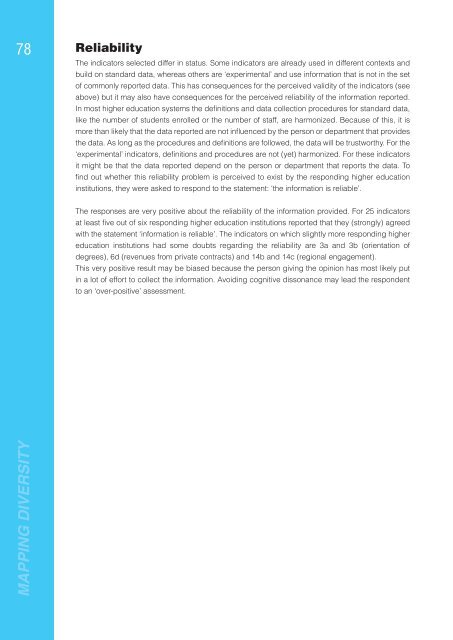Mapping Diversity: Developing a European Classification of ... - U-Map
Mapping Diversity: Developing a European Classification of ... - U-Map
Mapping Diversity: Developing a European Classification of ... - U-Map
Create successful ePaper yourself
Turn your PDF publications into a flip-book with our unique Google optimized e-Paper software.
78 Reliability<br />
The indicators selected differ in status. Some indicators are already used in different contexts and<br />
build on standard data, whereas others are ‘experimental’ and use information that is not in the set<br />
<strong>of</strong> commonly reported data. This has consequences for the perceived validity <strong>of</strong> the indicators (see<br />
above) but it may also have consequences for the perceived reliability <strong>of</strong> the information reported.<br />
In most higher education systems the defi nitions and data collection procedures for standard data,<br />
like the number <strong>of</strong> students enrolled or the number <strong>of</strong> staff, are harmonized. Because <strong>of</strong> this, it is<br />
more than likely that the data reported are not infl uenced by the person or department that provides<br />
the data. As long as the procedures and defi nitions are followed, the data will be trustworthy. For the<br />
‘experimental’ indicators, defi nitions and procedures are not (yet) harmonized. For these indicators<br />
it might be that the data reported depend on the person or department that reports the data. To<br />
fi nd out whether this reliability problem is perceived to exist by the responding higher education<br />
institutions, they were asked to respond to the statement: ‘the information is reliable’.<br />
The responses are very positive about the reliability <strong>of</strong> the information provided. For 25 indicators<br />
at least fi ve out <strong>of</strong> six responding higher education institutions reported that they (strongly) agreed<br />
with the statement ‘information is reliable’. The indicators on which slightly more responding higher<br />
education institutions had some doubts regarding the reliability are 3a and 3b (orientation <strong>of</strong><br />
degrees), 6d (revenues from private contracts) and 14b and 14c (regional engagement).<br />
This very positive result may be biased because the person giving the opinion has most likely put<br />
in a lot <strong>of</strong> effort to collect the information. Avoiding cognitive dissonance may lead the respondent<br />
to an ‘over-positive’ assessment.<br />
MAPPING DIVERSITY

















